
Newel K. Whitney Store
Newel K. Whitney
Newel began his career as a merchant at age 19 selling merchandise to the soldiers enlisted in the war of 1812. He traded with the American Indians and then worked as a store clerk for Sidney Gilbert where he was taught the value of record keeping. In 1821 Newel moved to Kirtland and opened his own store. He married Elizabeth Ann Smith in 1822. He built the Red Store where he and Ann lived and worked. (See Pix #1 )
The Erie Canal was soon completed where goods from the east coast could easily be shipped to Fairport Harbor (just 12 miles from Kirtland), this greatly improved Newel’s chances for running a successful business. In 1826 he built the Whitney Store called by locals the “White Store” and brought in his friend, Sidney Gilbert, as a partner (The Gilberts probably lived in the Red Store from 1827-1831).
The partnership of N. K. Whitney and Co. prospered as a business by keeping meticulous records, carrying a large inventory and charging fair prices. Because of his meticulous records we know the exact inventory he carried in the store.
The Significance of the Newel K. Whitney Store in Kirtland.
The Newel K. Whitney store was not only a successful business but for 18 months served as the actual location of the headquarters of the Church. After Newel K. Whitney was ordained the first bishop in Kirtland, it was the place of the first bishop’s storehouse. Joseph received sixteen revelations (contained in the Doctrine and Covenants), while he and Emma resided in the store. He met with Church leaders there to plan Church programs and provide instruction. Joseph translated portions of the bible while living at the store. The plans for building the temple were given there and sacred ordinances were performed in the store.
A Tour of the Store
On the way to the Whitney store you cross over Stoney Brook and talk about baptisms. The Stoney Brook Creek empties into the Chagrin River (Pix #2), where the saints made a dam to create a baptismal pond. The most interesting story here was when Willard Richards was baptized by his cousin, Brigham Young. Willard insisted on being baptized on December 31, 1836 at sundown signifying his new birth into a new life. They had to chop a large hole in the ice (he was a large man) and Brigham Young went down in the water to baptize him. Brigham later commented that he would not have done it if Willard had not been his cousin.
You pass by our little 100+ year old home, where we now live (Pix #3), and then stop by where the tannery (Pix #4) used to be, next to the Newel K. Whitney store. We talk for a minute about Sidney Rigdon. When Sidney joined the church he gave up his home, employment and income as a popular Reformed Baptist Minister. Sidney had once worked in a tannery and knew the trade and was able to go to work in the tannery next to the Whitney store.
When we arrive at the Whitney store (Pixs # 5, 6), most people ask to have their pictures taken in front of the store (a perfect place). The store structure is about 85% original. When people walk through the front door, into the store, we tell them they are walking through the original door that the Prophet Joseph Smith would have walk through (pix #7) when he arrived in Kirtland in February of 1831 and declared to Newel K. Whitney, “Thou art the man”, Newel answered by saying, “you have the advantage of me. You seem to know who I am but I don’t know who you are.” Joseph replied, “I am Joseph the Prophet, you prayed me here, now what do you want of me.”
The store in the 1830’s was filled with items from Europe and the east coast brought to Kirtland along the Erie Canal and Lake Erie. (Pix #8) The only item that is original in the first room we enter is the key that unlocked the front door to the store (Pix #9).
The next room we enter we call the trade and barter room (Pix #10). Since cash was in short supply, most people would bring items to the store they had made, grown or acquired. Newel would asses a value and give them a voucher to purchase items they needed in the store. The trade and barter room was also used as the first bishop’s storehouse when Newel K. Whitney was called as the first bishop in Kirtland.
Newel K. Whitney provided living quarters for Joseph and Emma on the second floor of the store. We go upstairs to Joseph Smith’s parlor (Pix #11). The floor is original and the Prophet would have walked here (Pix #12) It was in this parlor where Joseph met with his counselors, Sidney Rigdon and Frederick G. Williams, along with many other brethren and visitors. The table they would meet around is original. In this room Joseph, the Prophet, received sixteen revelations comprising sections 84-98, and 101 of the Doctrine and Covenants. Some of the revelations we mention, that were received in this room, are the “olive leaf” (D&C 84), the parable of the wheat and the tares (D&C 86), the prophecy on war (D&C 87), the oath and covenant of the priesthood (D&C 88), the Word of Wisdom (D&C 89), and the vision of how to construct the temple (D&C 94-95).
The School of the Prophet
Prior to the completion of the temple and before the School of the Prophets held its first meeting, in January, 1833, the Lord had outlined the order of the School, requirements for attendance and how it was to be organized and conducted (D&C 88:127-141). They were to “teach one another the doctrine of the kingdom” before being sent out as missionaries. The School of the Prophets was the first formal educational program of the Church. There were approximately 24 men who met there regularly in this first school. All but two of the men smoked and chewed tobacco, which led to Joseph Smith inquiring of the Lord and receiving the revelation known as the Word of Wisdom (D&C 89). Though just a small room in the Whitney store, measuring 11′ x 14′ (Pix #13), it was a sacred gathering place. The Lord referred to it as “the house of God,” “mine house,” “the house of the Lord,” and a “a sanctuary, a tabernacle of the Holy Spirit.” (D&C 88: 129-137). During the setting apart of the First Presidency, some of the brethren in the meeting were honored by having both The Father and The Son reveal themselves. The testifiers included the Prophet Joseph Smith, Frederick G. Williams, Zebedee Coltrin, and John Murdock.
The next room we see is Joseph and Emma’s bedroom, where Joseph Smith III was born and where Julia Murdock slept in the trundle bed (Pix #14).
The hired man’s room was where inventory for the store was kept and where a hired man slept (Pix #15). Perhaps the most notable hired man was Orson Hide, who worked for Newel K. Whitney before he joined the Church.
We go downstairs to Emma’s kitchen (Pix #16). Women in the 1830’s preferred cooking over an open fire. It would be more like Dutch Oven cooking is for us today. Emma and Ann Whitney could cook large quantities at a time with this set-up. Joseph received many visitors and they were sometimes cooking for as many as 30 people at times. The oven they used is called a bustle oven where a fire was built and the bricks heated up to baking temperature, then the coals were removed and 12 to 15 loaves of bread could be baked at a time.
We exit the store and move on to the Whitney home.
-
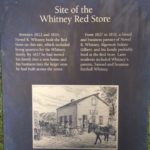
Red Store (Pix #1)
-
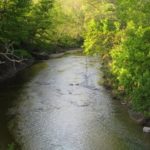
Chagrin River (Pix #2)
-
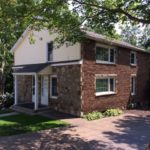
Our Home (Pix #3)
-
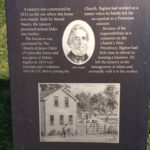
Tannery (Pix #4)
-
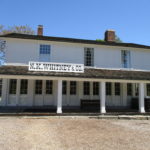
Whitney store (Pix #5)
-
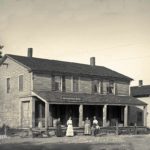
Early 1900's (Pix #6)
-
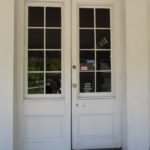
Original door (Pix #7)
-
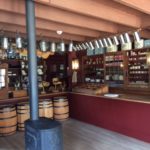
Store (Pix #8)
-
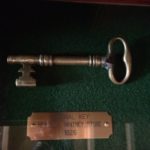
Original Key (Pix #9)
-
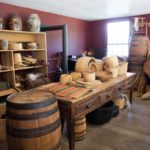
Trade and barter room (Pix #10)
-
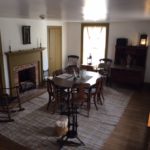
Parlor (Pix #11)
-
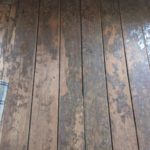
Original floor (Pix #12)
-
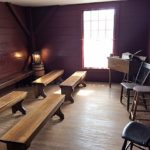
School (Pix #13)
-
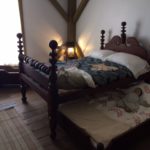
Bedroom (Pix #14)
-
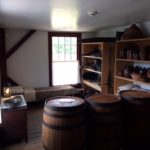
Hired Man (Pix #15)
-
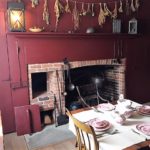
Emma's Kitchen (Pix #16)
